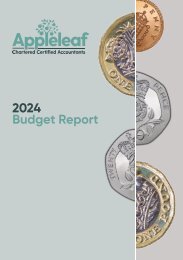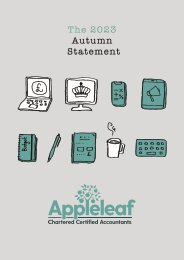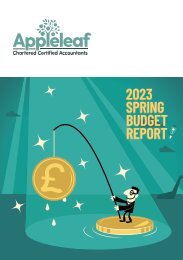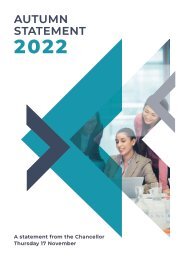Mini-Budget 2022
Create successful ePaper yourself
Turn your PDF publications into a flip-book with our unique Google optimized e-Paper software.
MINI BUDGET<br />
AN UPDATE<br />
Monday 17 October<br />
<strong>2022</strong>
CHANCELLOR BRINGS FORWARD<br />
FURTHER MEDIUM-TERM FISCAL PLAN<br />
MEASURES<br />
As the saying goes, a week is a long time in politics. However,<br />
recent events have been unprecedented. At the <strong>Mini</strong> <strong>Budget</strong> a<br />
new Prime <strong>Mini</strong>ster and Chancellor launched a new agenda,<br />
‘The Growth Plan’.<br />
Three weeks later, after huge turmoil, a reversal of most of<br />
the elements of that plan and a new statement planned for 31<br />
October. This is now being referred to as the Medium-Term<br />
Fiscal Plan, where the Chancellor will publish the government’s<br />
fiscal rules alongside an Office for <strong>Budget</strong> Responsibility<br />
forecast, together with what are described as ‘further measures’.<br />
The changes outlined on 17 October are designed to ensure<br />
the UK’s economic stability and provide confidence in the<br />
government’s commitment to fiscal discipline. Below, we have<br />
outlined the current position.<br />
National Insurance contributions<br />
In September 2021 the government published its proposals<br />
for new investment in health and social care in England. The<br />
proposals were intended to lead to a permanent increase<br />
in spending not only in England but also by the devolved<br />
governments. To fund the investment the government<br />
introduced a UK-wide 1.25% Health and Social Care Levy based<br />
on the National Insurance contributions (NICs) system but<br />
ringfenced for health and social care.<br />
However, the government has confirmed that it will:<br />
• reverse the temporary increase in NICs from November and<br />
• cancel the Health and Social Care Levy completely.<br />
Comment<br />
According to the government, not proceeding with the Levy will<br />
reduce tax for 920,000 businesses by nearly £10,000 on average<br />
next year.<br />
For SMEs, the government predicts that the savings will be around<br />
£4,200 on average for small businesses and £21,700 for medium<br />
sized firms from 2023/24.<br />
In addition, it will help almost 28 million people across the UK save<br />
£330 on average in 2023/24, with an additional saving of around<br />
£135 on average this year.<br />
More detail for employees and employers<br />
The changes take effect for payments of earnings made on or<br />
after 6 November <strong>2022</strong>, so:<br />
• primary Class 1 NICs (employees) will generally reduce from<br />
13.25% to 12% and 3.25% to 2% and<br />
• secondary Class 1 NICs (employers) will reduce from 15.05%<br />
to 13.8%.<br />
The Health and Social Care Levy Act provided for a temporary<br />
1.25% increase to both the main and additional rates of Class 1,<br />
Class 1A, Class 1B and Class 4 NICs for <strong>2022</strong>/23. From April 2023<br />
onwards, the NIC rates were intended to revert back to 2021/22<br />
levels and be replaced by a new 1.25% Health and Social Care<br />
Levy.<br />
The effect on Class 1A (payable by employers on taxable<br />
benefits in kind) and Class 1B (payable by employers on PAYE<br />
Settlement Agreements) NICs will effectively be averaged over<br />
the <strong>2022</strong>/23 tax year, so that the rate will generally be 14.53%.<br />
Comment<br />
The government hopes that most employees will receive the<br />
NICs reduction directly via the payroll in their November pay but<br />
acknowledges that some will have to wait until December or<br />
January, depending on the complexity of their employer’s payroll<br />
software.<br />
1
More detail for the self-employed<br />
Following the principle detailed above, the changes to Class 4<br />
NICs will again be averaged across <strong>2022</strong>/23, so that the rates will<br />
be 9.73% and 2.73%.<br />
Income tax<br />
Income tax rates<br />
The government had previously announced that there would<br />
be a cut in the basic rate of income tax, from 20% to 19%,<br />
from April 2024. This was to be accelerated so that it took<br />
effect from April 2023. However, whilst the government aims<br />
to proceed with the cut in due course, this will only take place<br />
when economic conditions allow and a change is affordable.<br />
The basic rate of income tax will therefore remain at 20%<br />
indefinitely.<br />
£1 million level of the AIA will become permanent and the<br />
proposed reduction will not occur.<br />
Up to 31 March 2023, companies investing in qualifying<br />
new plant and machinery are able to benefit from capital<br />
allowances, generally referred to as ‘super-deductions’. These<br />
reliefs are not available for unincorporated businesses.<br />
Interestingly, these allowances were not mentioned in any<br />
statement, other than minor amendments to the current rules,<br />
so it appears the scheduled withdrawal of them will occur in<br />
At the <strong>Mini</strong> <strong>Budget</strong> on 23 September the government announced<br />
a plan to abolish the 45% additional rate of income tax from<br />
April 2023. However, it was announced on 3 October that the<br />
government would not proceed with the abolition of the 45p tax<br />
rate.<br />
Dividends<br />
The government has also confirmed that, from April 2023, the<br />
1.25% proposed reduction in rates of taxation will not proceed,<br />
meaning that the rates will stay as follows:<br />
• the dividend ordinary rate - 8.75%<br />
• the dividend upper rate - 33.75%<br />
• the dividend additional rate - 39.35%.<br />
As corporation tax due on directors’ overdrawn loan accounts is<br />
paid at the dividend upper rate, this will also remain at 33.75%.<br />
These changes will apply in Scotland and Wales as the rules on<br />
dividends apply to the whole of the UK.<br />
2023.<br />
Comment<br />
Businesses incurring expenditure on plant and machinery should<br />
carefully consider the timing of their acquisitions to optimise their<br />
cashflow.<br />
Business<br />
Corporation tax rates<br />
It had been previously announced that the expected increase<br />
in the rate of corporation tax for many companies from April<br />
2023 to 25% would not go ahead. However the government<br />
announced on 14 October that this increase will now proceed.<br />
This means that, from April 2023, the rate will increase to 25%<br />
for companies with profits over £250,000. The 19% rate will<br />
become a small profits rate payable by companies with profits<br />
of £50,000 or less. Companies with profits between £50,001 and<br />
£250,000 will pay tax at the main rate reduced by a marginal<br />
relief, providing a gradual increase in the effective corporation<br />
tax rate.<br />
Capital allowances<br />
The Annual Investment Allowance (AIA) gives a 100% write-off<br />
on certain types of plant and machinery up to certain financial<br />
limits per 12-month period. The limit has been £1 million for<br />
some time but was scheduled to reduce to £200,000 from April<br />
2023. The government has announced that the temporary<br />
Seed Enterprise Investment Scheme<br />
From April 2023, companies will be able to raise up to £250,000<br />
of Seed Enterprise Investment Scheme (SEIS) investment, a<br />
two-thirds increase. To enable more companies to use SEIS, the<br />
gross asset limit will be increased to £350,000 and the age limit<br />
from two to three years. To support these increases, the annual<br />
investor limit will be doubled to £200,000.<br />
Company Share Option Plan<br />
From April 2023, qualifying companies will be able to issue up<br />
to £60,000 of Company Share Option Plan (CSOP) options to<br />
employees, twice the current £30,000 limit. The ‘worth having’<br />
restriction on share classes within CSOP will be eased, better<br />
aligning the scheme rules with the rules in the Enterprise<br />
Management Incentive scheme and widening access to CSOP<br />
for growth companies.<br />
Stamp Duty Land Tax<br />
A number of changes are made to the Stamp Duty Land Tax<br />
(SDLT) regime. Generally, the changes increase the amount<br />
that a purchaser can pay for residential property before they<br />
become liable for SDLT.<br />
2
The residential nil rate tax threshold is increased from £125,000<br />
to £250,000.<br />
The nil rate threshold for First Time Buyers’ Relief is increased<br />
from £300,000 to £425,000 and the maximum amount that an<br />
individual can pay while remaining eligible for First Time<br />
Buyers’ Relief is increased to £625,000.<br />
IR35 and off-payrolling<br />
Over the last 20 years, there have been numerous changes to<br />
the tax system to try and address ‘disguised employment’ and<br />
to generate additional tax and NICs accordingly. In a surprise<br />
announcement, the government had stated that it would repeal<br />
the off-payroll working rules from 6 April 2023. However, it has<br />
been confirmed that this change will not go ahead and the offpayrolling<br />
rules will remain in force.<br />
VAT-free shopping areas<br />
The government had announced that it would introduce a<br />
modern, digital, VAT-free shopping scheme with the aim of<br />
providing a boost to the high street and creating jobs in the<br />
retail and tourism sectors. However, this change will not go<br />
ahead either.<br />
The changes apply to transactions with effective dates on and<br />
after 23 September <strong>2022</strong> in England and Northern Ireland.<br />
These changes do not apply to Scotland or Wales which operate<br />
their own land transactions taxes.<br />
There are no changes in relation to purchases of non-residential<br />
property.<br />
Residential<br />
Band £<br />
Rate<br />
%<br />
Non-residential<br />
Band £<br />
Rate<br />
%<br />
0 - 250,000 0 0 - 150,000 0<br />
250,001 - 925,000 5 150,001 - 250,000 2<br />
925,001 - 1,500,000 10 Over 250,000 5<br />
Over 1,500,000 12<br />
Higher rates may be payable where further residential<br />
properties are acquired.<br />
Land Transaction Tax<br />
The Welsh government has also altered its rates in relation to<br />
land and buildings in Wales for transactions with an effective<br />
date on or after 10 October <strong>2022</strong>.<br />
Alcohol duties<br />
The government had announced that it would freeze alcohol<br />
duty rates from 1 February 2023 but this will not go ahead.<br />
Energy bills<br />
The government has announced unprecedented support to<br />
protect households and businesses from high energy prices.<br />
The Energy Price Guarantee and the Energy Bill Relief Scheme<br />
are supporting millions of households and businesses with<br />
rising energy costs and the government has stated that these<br />
schemes will continue to do so from now until April next year.<br />
However, the government states ‘that it would be<br />
irresponsible…to continue exposing the public finances to<br />
unlimited volatility in international gas prices’.<br />
Consequently, a Treasury-led review will be launched to<br />
consider how to support households and businesses with<br />
energy bills after April 2023. The aim is to design a new<br />
approach that will cost the taxpayer significantly less than<br />
planned whilst ensuring enough support for those in need. The<br />
government has also stated that any support for businesses will<br />
be targeted to those most affected and that the new approach<br />
will better incentivise energy efficiency.<br />
However, this is not the end of the story. Government<br />
departments will be asked to find efficiencies within their<br />
budgets and the Chancellor is expected to announce further<br />
changes to fiscal policy on 31 October to put the public finances<br />
on a sustainable footing.<br />
Residential<br />
Band £<br />
Rate<br />
%<br />
Non-residential<br />
Band £<br />
Rate<br />
%<br />
0 - 225,000 0 0 - 225,000 0<br />
225,001 - 400,000 6 225,001 - 250,000 1<br />
400,001 - 750,000 7.5 250,001 - 1,000,000 5<br />
750,001 - 1,500,000 10 Over 1,000,000 6<br />
Over 1,500,000 12<br />
Higher rates may be payable where further residential<br />
properties are acquired.<br />
Disclaimer: Whilst we take care to ensure the accuracy of this document, no responsibility for loss incurred by any person acting or refraining from action as a result of this information can be<br />
accepted by the authors or firm.<br />
3

















